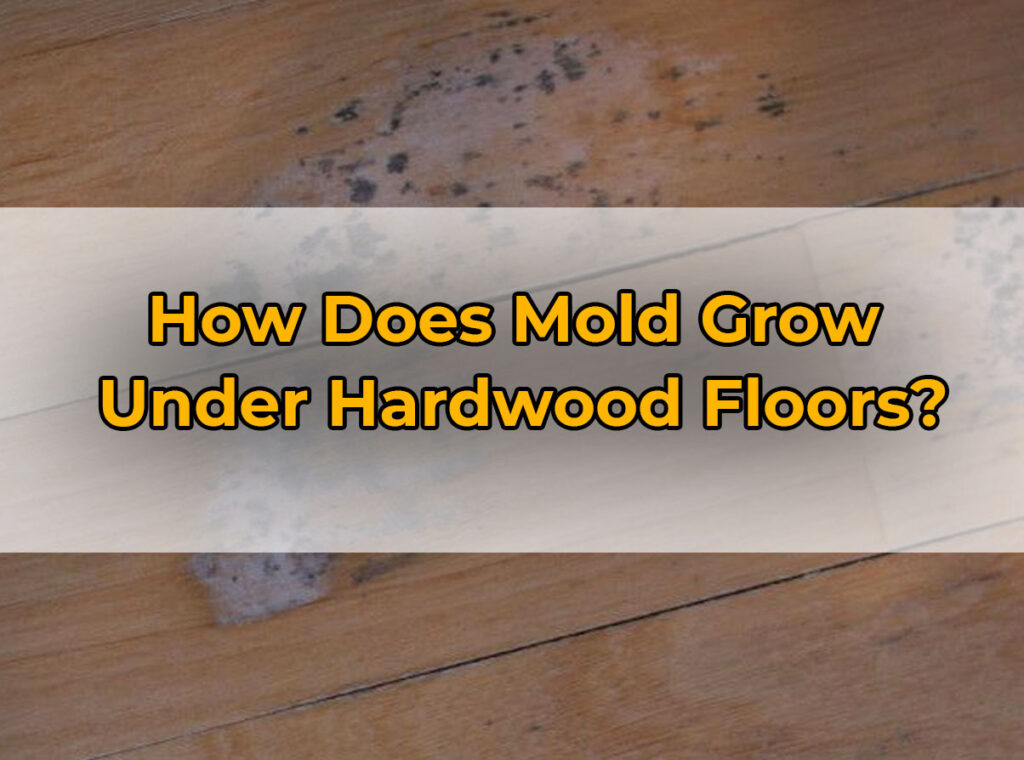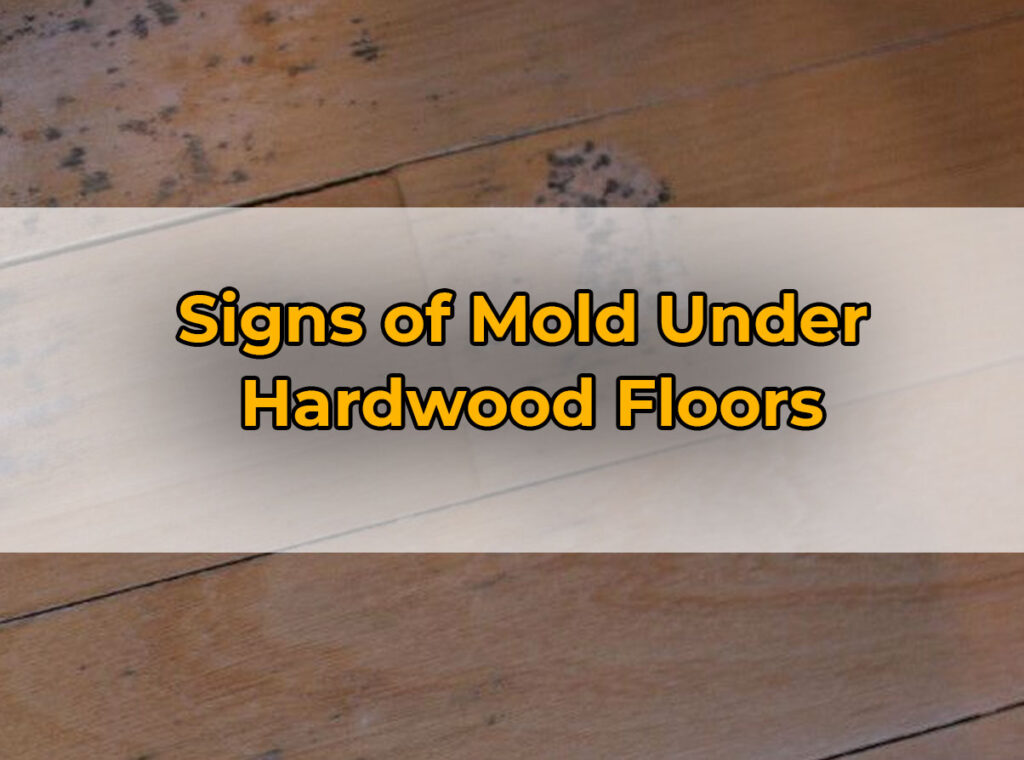To understand the signs of mold under hardwood floors, its better to know the cause of the mold growing.
If you’re a homeowner with hardwood floors, it’s essential to keep an eye out for signs of mold growth. Mold is a type of fungus that thrives in damp and humid environments and can cause significant health problems if left unaddressed.
Unfortunately, mold under hardwood floors is often challenging to detect until the problem has become severe.
What is Mold?
Mold is a fungus that loves damp spots. Inside and outside, it comes in many shapes and colors. Its spores fly through the air, causing breathing problems.
To keep mold away, keep humidity levels low. Also, clean often where it may grow. Don’t let mold surprise you! Protect your health – keep your area clean and dry!
How Does Mold Grow Under Hardwood Floors?

Mold, beware! Excessive moisture in your hardwood floors is a common issue. It loves to thrive in damp environments and water damage could be to blame. Improper installation or leaky plumbing may be the culprit.
Act fast if you spot any sign of mold. Discoloration or musty odors are usually a tell-tale sign. Use a hygrometer to measure the relative humidity level. Anything above 60% increases the chances of mold growth.
Don’t hesitate to contact mold remediation experts if there is any excess moisture or water damage under your hardwood floor. Mold can be hazardous to your health, furniture, and property. Don’t wait until it’s too late to take action!”
Signs of Mold Under Hardwood Floors

To identify signs of mold under hardwood floors with visible stains or discoloration, musty odor, warping or cupping of hardwood, increased humidity levels, and respiratory problems. These sub-sections will help you recognize if your hardwood floors have been affected by mold.
1. Visible Stains or Discoloration
Discolored stains on hardwood floors might be a sign of mold growth! They often look yellow or green, splotchy or spread out. If left untreated, mold can cause floor damage and health risks.
Check for other signs, like musty odor and allergies. Peek under flooring to see if there’s moisture or mold.
Water damage, like from flooding or leaks, can lead to mold too. One homeowner got huge black stains after a flood – they had to replace it all. So, watch for discolored stains on your hardwood and act fast! Your nose will tell you if there’s mold around.
2. Musty Odor
Mold under hardwood floors isn’t rare. A musty odor is the first sign homeowners notice. This smell can be strong, especially in humid places or if mold has been growing for a while.
Mold releases spores that can cause breathing issues or allergies. It’s important to identify and deal with mold issues quickly. If you smell a musty odor, it’s time to investigate further.
You may also see discoloration or warping of the wood. Not all mold growth is visible, so even if you don’t spot anything, there could still be an issue.
Sometimes, homeowners discover extensive mold growth under their hardwood flooring after experiencing health problems. Remediation efforts or whole sections of flooring replacement may be needed in some cases.
It’s better to be safe than sorry when it comes to mold detection. If you suspect a problem with your hardwood floors, seek professional help right away to avoid dangerous situations in your home.
3. Warping or Cupping of Hardwood
Hardwood floors can bring warmth and beauty to a home, but they can also hide something unpleasant. Warping or cupping of hardwood is a sign of mold growth underneath. This happens when the bottom of the wood gets wet, making it swell and pushing the edges, resulting in an uneven surface.
There’s no need to ignore this; it could be an indication of a bigger issue! Mold loves damp, humid, and poorly ventilated areas – and the organic material in wood is perfect for its spores to feed on.
4. Increased Humidity Levels
Excessive humidity in your home can lead to mold growth – not just in visible areas. Hardwood floors are especially prone, as they are porous and absorb moisture. If installed over a concrete subfloor without proper moisture barriers or ventilation, it’s a breeding ground for mold.
Trouble! This mold can trigger allergies or worsen respiratory illnesses. Plus, it attracts pests like termites and carpenter ants, which can damage the wood flooring. Be alert for signs like warping, buckling, staining or discoloration – or a musty smell.
Humidity levels should stay between 30% and 50%. If you notice any of these indicators, get professional help. Don’t let mold ruin your beautiful flooring. Take swift action before it causes damage or health hazards for your family.
Maintain optimum humidity and schedule periodic inspections with certified professionals. Keep everything spic-and-span and healthy!
5. Respiratory Problems
Mold under hardwood floors can bring respiratory issues like coughing, wheezing and breathlessness. Musty smell or visible growth of mold requires professional testing and removal. Mold spores can drift in air and irritate lungs, having more severe effects on those with allergies or asthma. If left untreated, it can worsen over time.
To avoid such hassles, make sure your home has proper ventilation and humidity control.
Apart from respiratory problems, mold can also cause skin and eye irritation. In serious cases, long-term exposure to mold can cause fungal diseases and lung damage.
Cleaning with a mild detergent and vacuuming with a HEPA filter vacuum cleaner regularly, can help prevent dirt and dust buildup, which can lead to mold growth. Check this Why Is Kilz Not Recommended For Flooring?
Causes of Mold Under Hardwood Floors
To understand the causes of mold under hardwood floors, solutions must target all possible culprits.
1. Moisture from Subfloor
Beneath hardwood floors, too much moisture from the subfloor can cause mold growth. It may seem small at first, but can lead to structural damage and health problems with long-term exposure. Moisture from the subfloor may rise and seep into the planks, damaging them.
Also, some flooring materials are not as tolerant of moisture. If the subfloor is wet, traditional hardwood flooring may not be the best option. You may need engineered wood or vinyl tile, which have better water protection.
2. Water Damages
Burst pipes, flooding, or even high humidity levels can cause this. Left untreated, it causes allergies and respiratory problems. Plus, pricey renovations!
But, proper ventilation can help. It reduces humidity levels and decreases the risk of mold. Inspect your flooring for signs of water damage or mildew odors often. If you suspect mold – seek professional help ASAP. Prevention is key!
3. Poor Ventilation
Poor ventilation can cause mold growth under hardwood floors. A humid, dark, and moist environment is ideal for mold. This can be dangerous and damages your home or business. Inadequate ventilation also traps moisture in the subflooring material, leading to structural damage. Water leaks and spills near the floor can linger if there is no proper ventilation.
To avoid these issues, consider investing in a ventilation system. Expert help from HVAC professionals is essential. Don’t skip this step, or you may face health concerns or costly remediation. Avoid the sauna: walking on hardwood floors after rain can do the trick!
4. High Humidity Levels
High humidity levels can cause mold to grow under hardwood floors. Poor ventilation, leaks, and inadequate temperature regulation can lead to moisture buildup.
Air with high humidity contains more moisture than it can hold. This excess moisture seeps through wood and contributes to mold growth. Hardwood floors block the moisture from leaving the atmosphere, creating a conducive environment for mold.
Prevent this by ensuring proper ventilation, fixing any leaks or faucets, and regulating the temperature.
5. Plumbing Leaks
Plumbing leaks can cause water damage and lead to mold growth under hardwood floors. Look for signs like dripping pipes, musty smells, and discolored floorboards. Timely detection and repair of plumbing issues is vital to keeping your floor safe. Ignoring them can create structural and health issues. Consider getting regular maintenance checks with a professional plumber.
Also, check with your insurance provider to see if they cover water damage from plumbing issues. If not, take immediate action to minimize any loss.
According to US EPA, 15 percent of American homeowners have experienced water leakage through toilets or faucets. To keep your hardwood floors free from fungus, take preventive steps now!
Prevention and Treatment of Mold Under Hardwood Floors

To prevent and treat mold under hardwood floors with ease, the section ‘Troubleshooting of Mold Under Hardwood Floors’.
1. Fixing Water Damages Immediately
Water damages can be extremely harmful to hardwood floors, leading to mold and structural ruin. It’s essential to take action promptly to fix water damages and stop further troubles. Here’s a 5-step guide to do it right away:
- Shut off the power to prevent electrocution.
- Use a wet/dry vacuum or mop to take out standing water.
- Move any wet carpets or furniture away from the affected area.
- Utilize dehumidifiers and fans to dry the area completely.
- Install a moisture barrier and replace damaged flooring if required.
It’s vital to note that postponing fixing water damages can result in higher repair costs, mold growth, and even health issues. A moisture meter can detect hidden water in walls or under floors.
You’re protecting your hardwood floors with preventative steps like fixing water damages immediately – that’s admirable! Remember, small investments now can save you big money in the future, maintain your home’s structural integrity, and keep your family safe from mold-related illnesses.
Don’t wait for it to be too late; take action now! Secure your hardwood floors from steamy situations by putting in a vapor barrier. Check also: How to Repair Swollen Laminate Flooring without Replacing.
2. Installing a Vapor Barrier
Installing a vapor barrier is vital to nixing mold growth beneath hardwood floors. It also helps to conserve energy and keep the indoor air quality nice. Here’s the 3 easy steps:
- Clean the subfloor, and make sure it is dry before you start.
- Cut the vapor barrier to fit the room, leaving a 6-inch overlap at the edges.
- Tape or glue down the barrier, and don’t leave any gaps.
It’s essential to remember that a bad vapor barrier install can lead to moisture build-up. This could harm the flooring and underlying joists and beams. If uncertain, get professional advice.
To prevent mold, it’s not just about the barrier – you must also keep the humidity in your home low. Ventilation, air conditioning, dehumidifiers, and plumbing maintenance are other options.
3. Proper Ventilation
Proper ventilation is key in keeping mold from growing beneath hardwood floors. It lets air move around, reducing humdity – aka moisture which encourages mold. Make sure all vents are open and put in exhaust fans to help with airflow.
However, just having ventilation is not enough. You must have the floor correctly installed with a moisture barrier to stop water from getting in. Also, inspect your home often for leaks or water damage.
The Environmental Protection Agency (EPA) conducted a study that revealed mold can cause respiratory problems, mainly in those with allergies or asthma. So, it is vital to take steps to prevent this.
Remember, just having ventilation is not enough. You must also keep the area dry. Doing this will help protect your family’s health and the condition of your home. Check also: Gap Between Tub and Floor
4. Dehumidifiers
Dehumidifiers are a must-have to extract excess moisture from the air. They help keep the humidity level between 30% to 50%, which is ideal for preventing mold growth. These machines need continuous operation to work properly, and you may need to manually drain them. Make sure to follow the manufacturer’s directions!
Also, remember to get the right size for your room or home – it should be based on square footage. Last but not least, don’t wait ’til your hardwood floors look like a horror movie set – get professional mold removal ASAP.
5. Professional Mold Removal
It’s crucial to have pro mold removal for hardwood floors. Trained technicians use specialized techniques to take away every trace of mold. They also figure out what’s causing the mold and fix that issue, such as fixing leaks or ventilation. Sealing hardwood floors can also help.
But DIY mold removal is a bad idea – it’ll make things worse and cause more health risks. The EPA says to hire a qualified professional for the job. Get tips from experts for successful prevention and treatment of mold. Let’s say goodbye to mold and hello to good wood!
How do you treat mold under hardwood floors?
The first step in treating mold under hardwood floors is identifying the source of the problem. This could be a leaky pipe, improper ventilation, or even flooding. Once you’ve identified the source of the issue, you’ll need to address it before you can start treating the mold itself. Fixing any leaks or improving ventilation will help prevent future growth.
To treat existing mold under hardwood floors, there are several options available depending on the severity of the infestation. You may need to remove and replace damaged flooring or subflooring entirely if it’s too far gone.
What kills mold under flooring?
The most effective way to kill mold under flooring is by removing the affected area. This involves cutting out the damaged section of the flooring and replacing it with new materials. It’s important to wear protective gear such as gloves, goggles, and a respirator mask when handling moldy materials.
Another option for killing mold under flooring is by using specialized cleaning products. There are many commercial products available that are specifically designed for removing mold from different surfaces including floors. These products usually contain powerful ingredients like bleach or hydrogen peroxide which can effectively kill mold spores on contact.
How long does it take for mold to grow on hardwood floors?
In general, if moisture levels remain high for an extended period of time, mold can begin growing within 24 to 48 hours.
Once mold begins to grow on hardwood floors, it can be challenging to remove completely. It is important to address any signs of mold growth immediately by identifying and fixing the source of moisture and cleaning the affected area thoroughly
“There is no real ending. It’s just the place where you stop the story.”






